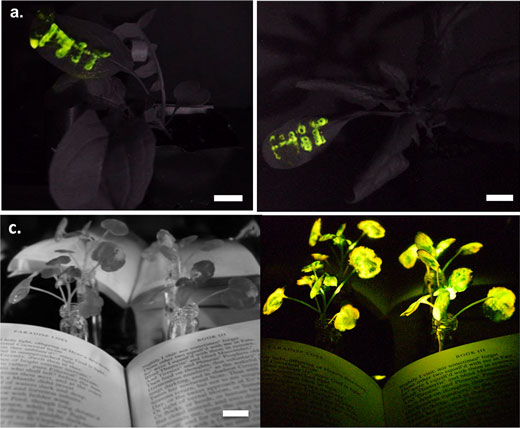| Posted: Jan 11, 2018 | |
Nanotechnology engineering of light-emitting plants(Nanowerk News) In a paper in Nano Letters ("A Nanobionic Light-Emitting Plant"), researchers have show for the first time the use of plants as self-powered light sources using exclusive nanotechnology approaches. |
|
| A research team from MIT and the University of California designed nanoparticles of controlled size, surface charge and biocompatibility for plant tissue localization to control biochemical pathways in living plants for new functions: converting native adenosine triphosphate (ATP) to chemiluminescence. | |
| This enables entire glowing plants, tissue specific patterning, and wavelength modulation through resonant energy transfer to create wild-type plants with persistent photonic sources for indirect lighting and IR communications. | |
 |
|
| Perspective utilization of light-emitting plants. (a) Illuminating MIT logo printed on the leaf of an arugula plant (left) and a spinach plant (right). The mixture of nanoparticles was infused to the leaf by using lab-designed syringe termination adaptors. The images are merged of the bright-field image and light emission in the dark. Photos were taken by Nikon D5300 at a set of 30 s exposure, f/4.5 and ISO 6400. Scale bar = 1 cm. (© ACS) | |
| Attempts to generate light-emitting plants have previously focused on genetic engineering using either the firefly luciferase gene or bacterial lux operon. A central complication with this approach is the difficulty in colocalizing reactive enzymes for chemiluminescence within substrate producing regions and high ATP concentration. | |
| The scientists note that their technique of pressurized bath infusion of nanoparticles (PBIN) is a newly developed method to deliver a mixture of nanoparticles to an entire living plant, and well described by a nanofluidic mathematical model. | |
| The team also introduce a detailed kinetic model for the description of how chemically interacting nanoparticles interface with existing biochemical pathways in the plant to convert ATP to photons for illumination. | |
| The authors point out that the design rules utilized for these nanoparticles also extend to broader applications, including gene delivery, biosynthesis, fertilizer, and pesticides. |
 By
Michael
Berger
– Michael is author of three books by the Royal Society of Chemistry:
Nano-Society: Pushing the Boundaries of Technology,
Nanotechnology: The Future is Tiny, and
Nanoengineering: The Skills and Tools Making Technology Invisible
Copyright ©
Nanowerk LLC
By
Michael
Berger
– Michael is author of three books by the Royal Society of Chemistry:
Nano-Society: Pushing the Boundaries of Technology,
Nanotechnology: The Future is Tiny, and
Nanoengineering: The Skills and Tools Making Technology Invisible
Copyright ©
Nanowerk LLC
|
|
|
Subscribe to a free copy of one of our daily Nanowerk Newsletter Email Digests with a compilation of all of the day's news. |
